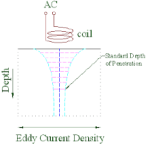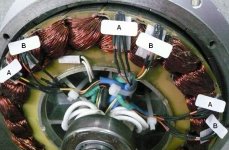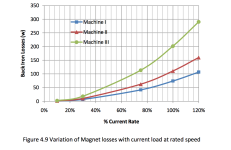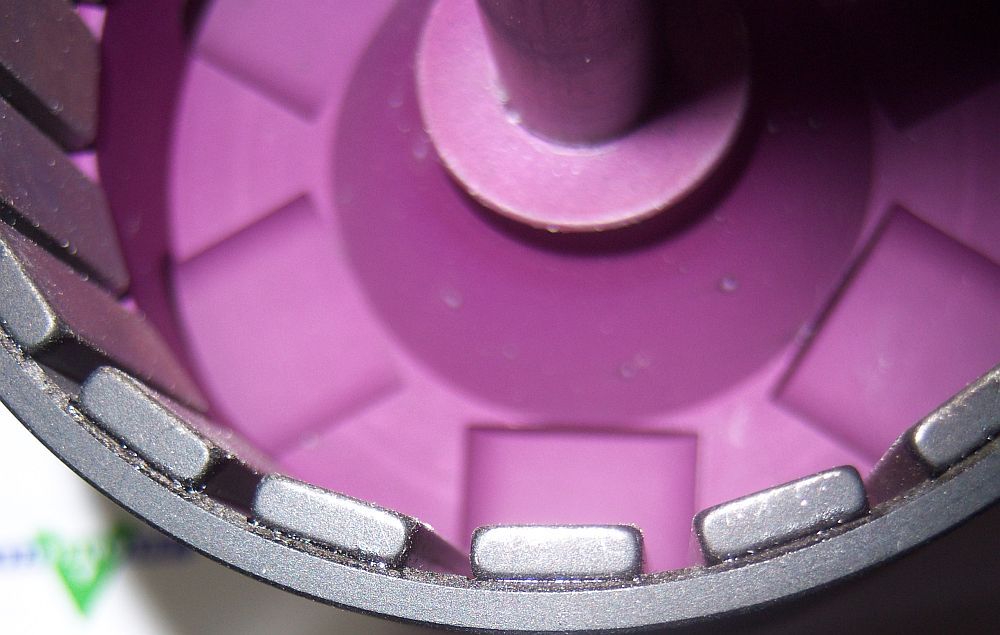Regarding the effect of slot and pole count i found this paper:
http://www.jimhendershot.com/Jim_He...ushlessdcmotorphasepoleslotconfigurations.pdf
Chapter "V Stator slots/windings" contains some meaningful informations.
There are graphs where the BEMF voltage and torque curve are shown for different slot/pole combinations.
I found it interesting that for instance the BEMF shape of an 4P12N stator is identical to an 6P18N or 8P24N because they all belong to the same category with three (3) slots per pole.
A stator with 8p18N or 16P18N for instance has a perfect sine-wave BEMF and torque curve with very low cogging torque.
Unfortunately there is no graph of the mentioned 20P24N design (0,833 slots per pole) or the 14P12N (1,166 slots per pole) like the motors from Revolt do have.
The question is if a motor design with sine-wave BEMF and torque curve (lowest cogging torque) would be equatable with an high efficient (low eddy losses etc.) design? Any ideas?
it seems that eddy currents only flow in horizontal direction in very thin "layers" if the alternating magnetic field penetrates the material vertically. Therefore the material is laminated in this direction as the benefit of reducing the eddys is the largest when doing so.
Thats how i understand it. Is it right?
View attachment 3


But i still try to find out what happens in the VERTICAL DIRECTION, and thats why the initial discussion started:
- Would there be a benefit to electrically isolating the magnets from the back iron?
- Or would there be any benefit of using epoxy coated magnets instead of magnets with conductive coating like nickel?
I found this paper very interesting:
http://chemical-biological.tpub.com/TM-1-1500-335-23/css/TM-1-1500-335-23_337.htm
4.2.2.1.4 Material Thickness.
In a part, such as sheet material, in which the thickness is less than the effective depth of penetration, the overallelectromagnetic field is not zero at the back surface. As the back surface gets closer to the front surface, the overallfield at the back surface increases; and as the back surface gets further from the front surface the overall field decreases. This provides a mechanism for thickness gauging of thin materials. Furthermore, a material of either lower or higher conductivity at the far side will change the magnitude and distribution of the eddy currents as shown in Figure 4-6. This provides a means for thickness gauging of thin, conductive coatings on substrates that are either more or less conductive than the coating.

Figure 4-6 shows the first material the magnetic field hits is the "thin conductor" which should be the same on both the left and right figure.
On left figure the "backing matrial" has higher conductivity and on the right side the backing material has less conductivity.
It looks like things change a bit in the "thin conductor" on top, but i am not 100% sure about it.
This can be applied between any two different, electrically conductive materials which are stacked in vertical direction. Like magnets on the back iron, or the coating of the magnet (eg. Nickel) on the magnet iteself (NdFeB).
http://www.jimhendershot.com/Jim_He...ushlessdcmotorphasepoleslotconfigurations.pdf
Chapter "V Stator slots/windings" contains some meaningful informations.
There are graphs where the BEMF voltage and torque curve are shown for different slot/pole combinations.
I found it interesting that for instance the BEMF shape of an 4P12N stator is identical to an 6P18N or 8P24N because they all belong to the same category with three (3) slots per pole.
A stator with 8p18N or 16P18N for instance has a perfect sine-wave BEMF and torque curve with very low cogging torque.
Unfortunately there is no graph of the mentioned 20P24N design (0,833 slots per pole) or the 14P12N (1,166 slots per pole) like the motors from Revolt do have.
The question is if a motor design with sine-wave BEMF and torque curve (lowest cogging torque) would be equatable with an high efficient (low eddy losses etc.) design? Any ideas?
Miles said:You're on a roll, Lars
Thanks for the useful references. Interesting how little the resistance between surfaces needs to be to avoid conduction of eddys.... I guess that's why you can get away with a thin oxide layer on stator laminations.
it seems that eddy currents only flow in horizontal direction in very thin "layers" if the alternating magnetic field penetrates the material vertically. Therefore the material is laminated in this direction as the benefit of reducing the eddys is the largest when doing so.
Thats how i understand it. Is it right?
View attachment 3


But i still try to find out what happens in the VERTICAL DIRECTION, and thats why the initial discussion started:
- Would there be a benefit to electrically isolating the magnets from the back iron?
- Or would there be any benefit of using epoxy coated magnets instead of magnets with conductive coating like nickel?
I found this paper very interesting:
http://chemical-biological.tpub.com/TM-1-1500-335-23/css/TM-1-1500-335-23_337.htm
4.2.2.1.4 Material Thickness.
In a part, such as sheet material, in which the thickness is less than the effective depth of penetration, the overallelectromagnetic field is not zero at the back surface. As the back surface gets closer to the front surface, the overallfield at the back surface increases; and as the back surface gets further from the front surface the overall field decreases. This provides a mechanism for thickness gauging of thin materials. Furthermore, a material of either lower or higher conductivity at the far side will change the magnitude and distribution of the eddy currents as shown in Figure 4-6. This provides a means for thickness gauging of thin, conductive coatings on substrates that are either more or less conductive than the coating.

Figure 4-6 shows the first material the magnetic field hits is the "thin conductor" which should be the same on both the left and right figure.
On left figure the "backing matrial" has higher conductivity and on the right side the backing material has less conductivity.
It looks like things change a bit in the "thin conductor" on top, but i am not 100% sure about it.
This can be applied between any two different, electrically conductive materials which are stacked in vertical direction. Like magnets on the back iron, or the coating of the magnet (eg. Nickel) on the magnet iteself (NdFeB).






